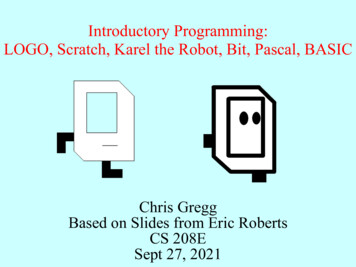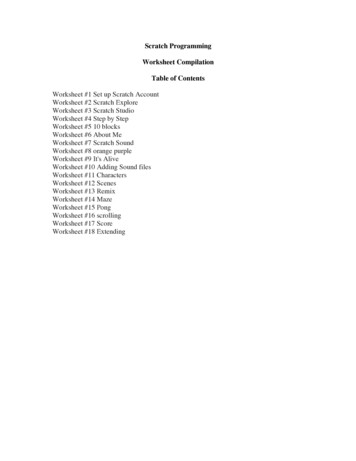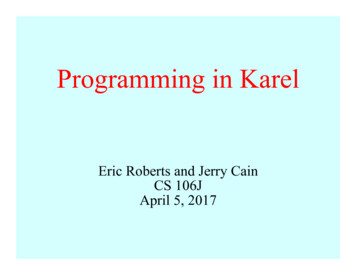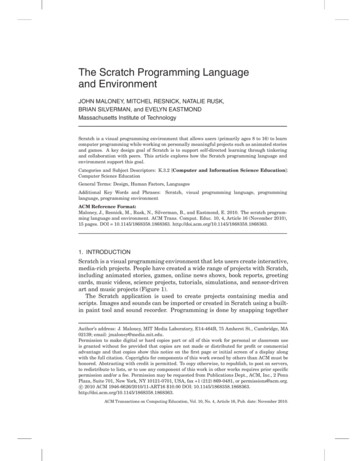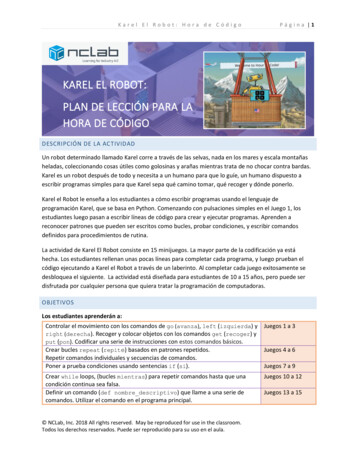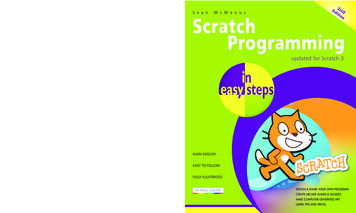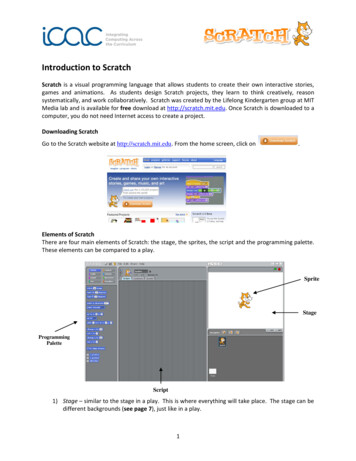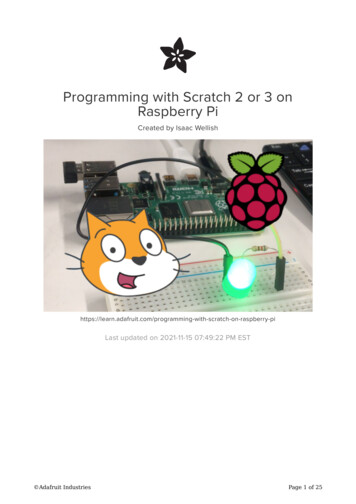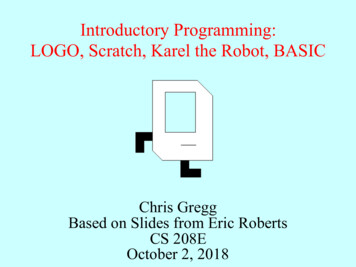
Transcription
Introductory Programming:LOGO, Scratch, Karel the Robot, BASICChris GreggBased on Slides from Eric RobertsCS 208EOctober 2, 2018
The Project LOGO Turtle In the 1960s, the late Seymour Papertand his colleagues at MIT developedthe Project LOGO turtle and beganusing it to teach schoolchildren howto program. The LOGO turtle was one of the firstexamples of a microworld, a simple,self-contained programmingenvironment designed for teaching. Papert described his experiences andhis theories about education in hisbook Mindstorms, which remains oneof the most important books aboutcomputer science pedagogy.
Programming the LOGO Turtleto squarerepeat 4forward 40left 90endendto flowerrepeat 36squareleft 10endend
The Logo Turtle in Python pythonPython 2.7.13 (v2.7.13:a06454b1afa1, Dec 17 2016, 12:39:47)[GCC 4.2.1 (Apple Inc. build 5666) (dot 3)] on darwinType "help", "copyright", "credits" or "license" for more information. from turtle import * def sun():.color('red','yellow').begin fill().while True:.forward(200).left(170).if abs(pos()) 1:.break.end fill().done(). sun()
Hi! I’m Ben Allen, I’m a grad student inthe MS in CS Education program I hold a PhD from the ModernThought and Literature program,where my committee includedmembers from Communication,History, and Rhetoric I’m interested in interdisciplinaryˇresearch in computer science,particularly in the history ofprogramming language design I’ve written articles defending widelyloathed programming languages
“Software crisis” In the 1960s, the term “softwarecrisis” was used to describe themajor problem in computing –because of the ongoing shortage oftrained programmers. This crisis never ended. Teaching good programmingpractice quickly has been aprimary concern since the earlydays of computing – and onestrategy is designing languagesthat are at least supposed to bequick to learn.
Bad ideas in computer history
How do we teach programming? How we teach programming dependson what we think programming is. The COBOL idea was that we shouldteach programming as Englishlanguage instructions. This didn’twork out On the right here is Edsger Dijkstra,maybe the most influential computerscientist not from Stanford. Dijkstra argued that we should teachprogramming as a radical novelty. Dijkstra on COBOL: “The use ofCOBOL cripples the mind; itsteaching, therefore, should beregarded as a criminal offense.
Cruelty, or, Dijkstra TeachesProgramming In “on the cruelty of really teaching computing science,”Dijkstra laid out a plan of instruction that he would laterimplement at UT Austin. For his intro to computing classes, he developed alanguage for which there was no compiler, and banned hisstudents from using computers to test their programs. To Dijkstra, computing was best understood as a newbranch of formal mathematics. With every assignment,students would have to prepare formal proofs of thecorrectness of their programs. This worked okay
”Lifelong Kindergarten”
Sophisticated Scratch
How do students actually use scratch?
Educational programming and newprogramming paradigms Consider that the first two widely used objectoriented languages (Smalltalk and Pascal) wereoriginally designed as educational languages, withSmalltalk explicitly designed as a tool forconstructivist learning Object orientation is more or less ubiquitous now:even fussy old COBOL supports it. Even if you’re not particularly interested in CSeducation, paying attention to educationalprogramming might still be worthwhile.
Rich Pattis and Karel the Robot Karel the Robot was developed byRich Pattis in the 1970s when he wasa graduate student at Stanford. In 1981, Pattis published Karel theRobot: A Gentle Introduction to theArt of Programming, which became abest-selling introductory text. Pattis chose the name Karel in honorof the Czech playwright Karel ˇCapek,who introduced the word robot in his1921 play R.U.R. In 2006, Pattis received the annualaward for Outstanding Contributionsto Computer Science Education givenby the ACM professional society.Rich Pattis
Meet Karel the Robot opedthat whichtheoveraremove.southwestsmall30 ttheinproblem,Manhattan,emitKarela ion”world,to thepassage.cornerKarel oftoisturnLeft()Turn90studentsdegreestoatheleftst pickBeeper()nd Avenue.stprogramming1facingStreeteastandat ick ofup 1asolving.beeperfromsquareputBeeper()Put down a beeper on the current square3 2 1 12345
Your First Challenge How would you program Karel to pick up the beeper andtransport it to the top of the ledge? Karel should drop thebeeper at the corner of 2nd Street and 4th Avenue and thencontinue one more corner to the east, ending up on 5th Avenue.3 2 1 12345
The moveBeeperToLedge Function/** File: MoveBeeperToLedge.k* ------------------------* This program moves a beeper up to a ledge.*/function moveBeeperToLedge() ve();}CommentsFunction implementing the desired action
Defining New Functions A Karel program consists of a collection of functions, each ofwhich is a sequence of statements that has been collectedtogether and given a name. The pattern for defining a newfunction looks like this:function name() {statements that implement the desired operation} In patterns of this sort, the boldfaced words are fixed parts ofthe pattern; the italicized parts represent the parts you canchange. Thus, every helper function will include the keywordfunction along with the parentheses and braces shown. Youget to choose the name and the sequence of statementsperforms the desired operation.
The turnRight Function As a simple example, the following function definition allowsKarel to turn right by executing three turnLeft operations:function turnRight() {turnLeft();turnLeft();turnLeft();} Once you have made this definition, you can use turnRightin your programs in exactly the same way you use turnLeft. In a sense, defining a new function is analogous to teachingKarel a new word. The name of the function becomes part ofKarel’s vocabulary and extends the set of operations the robotcan perform.
Adding Functions to a Program/** File: MoveBeeperToLedge.k* ------------------------* This program moves a beeper up to a ledge using turnRight.*/function moveBeeperToLedge() Right();move();putBeeper();move();}function turnRight() {turnLeft();turnLeft();turnLeft();}
Exercise: Defining Functions Define a function called turnAround that turns Karel around180 degrees without moving.function turnAround() {turnLeft();turnLeft();} Define a function backup that moves Karel backward onesquare, leaving Karel facing in the same direction.function backup() {turnAround();move();turnAround();}
Control Statements In addition to allowing you to define new functions, Karel alsoincludes three statement forms that allow you to change theorder in which statements are executed. Such statements arecalled control statements. The control statements available in Karel are:– The repeat statement, which is used to repeat a set ofstatements a predetermined number of times.– The while statement, which repeats a set of statements as longas some condition holds.– The if statement, which applies a conditional test to determinewhether a set of statements should be executed at all.– The if-else statement, which uses a conditional test to choosebetween two possible actions.
The repeat Statement In Karel, the repeat statement has the following form:repeat (count) {statements to be repeated} Like most control statements, the repeat statement consists oftwo parts:– The header line, which specifies the number of repetitions– The body, which is the set of statements affected by the repeat Note that most of the header line appears in boldface, whichmeans that it is a fixed part of the repeat statement pattern.The only thing you are allowed to change is the number ofrepetitions, which is indicated by the placeholder count.
Using the repeat Statement You can use repeat to redefine turnRight as follows:function turnRight() {repeat (3) {turnLeft();}} The following function creates a square of four beepers,leaving Karel in its original position:function makeBeeperSquare() {repeat (4) {putBeeper();move();turnLeft();}}
Conditions in Karel Karel can test the following conditions:positive conditionnegative ngWest()notFacingWest()
The while Statement The general form of the while statement looks like this:while (condition) {statements to be repeated} The simplest example of the while statement is the functionmoveToWall, which comes in handy in lots of programs:function moveToWall() {while (frontIsClear()) {move();}}
The if and if-else Statements The if statement in Karel comes in two forms:– A simple if statement for situations in which you may or maynot want to perform an action:if (condition) {statements to be executed if the condition is true}– An if-else statement for situations in which you must choosebetween two different actions:if (condition) {statements to be executed if the condition is true} else {statements to be executed if the condition is false}
Exercise: Creating a Beeper Line Write a function putBeeperLine that adds one beeper to everyintersection up to the next wall. Your function should operate correctly no matter how farKarel is from the wall or what direction Karel is facing. Consider, for example, the following function called test:function test() 2345
Climbing Mountains Our next task explores the use of functions and controlstatements in the context of teaching Karel to climb stair-stepmountains that look something like this:3211234567 Our first program will work only in a particular world, but thegoal is to have Karel be able to climb any stair-step mountain.
Stepwise Refinement The most effective way to solve a complex problem is to breakit down into successively simpler subproblems. You start by breaking the whole task down into simpler parts. Some of those tasks may themselves need subdivision. This process is called stepwise refinement or decomposition.Complete TaskSubtask #1Subtask #2Subsubtask #2aSubsubtask #2bSubtask #3
Criteria for Choosing a Decomposition1. The proposed steps should be easy to explain.Oneindication that you have succeeded is being able to findsimple names.2. The steps should be as general as possible. Programmingtools get reused all the time. If your functions performgeneral tasks, they are much easier to reuse.3. The steps should make sense at the level of abstraction atwhich they are used. If you have a function that does theright job but whose name doesn’t make sense in the contextof the problem, it is probably worth defining a new functionthat calls the old one.
Exercise: Banishing Winter In this problem, Karel is supposed to usher in springtime byplacing bundles of leaves at the top of each “tree” in the world. Given this initial world, the final state should look like this:6 5 4 3 2 1 1234567891011121314
Understanding the Problem One of the first things you need to do given a problem of thissort is to make sure you understand all the details. In this problem, it is easiest to have Karel stop when it runsout of beepers. Why can’t it just stop at the end of 1st Street?6 5 4 3 2 1 1234567891011121314
The Top-Level Decomposition You can break this program down into two tasks that areexecuted repeatedly: – Find the next tree. – Decorate that tree with leaves. 6 5 4 3 2 1 1234567891011121314
BASICThe BASIC language, created in 1964 by John G. Kemeny andThomas E. Kurtz at Dartmouth, was the programming language thatwas included with home computers during the 1970s and 1980s.The language was usually included in ROM, so that when thecomputer booted up, users could immediately start programming.
BASICBASIC was designedso that students innon-scientific fieldscould learn toprogram.Students learnedBASIC in school, orby reading books thathad listing ofprograms (oftengames) that they couldtype in relativelyquickly.Family Computing Magazine, July 1985
BASICWhile BASIC was relatively easy to learn, and while it introducedmillions of kids to programming, it is not a particularly good language(at least the 1980s version — today, Visual Basic is decent). It is notFamously, Edsgar Dijkstra said, in 1975, "It is practically impossibleto teach good programming to students that have had a prior exposureto BASIC: as potential programmers they are mentally mutilatedbeyond hope of regeneration."Students who learned BASIC on their own do, indeed, have sometrouble graduating to a structured language such as C, Java,Javascript, etc., but it is probably not as dire as Dijkstra led on.
The End
on what we think programming is. The COBOL idea was that we should teach programming as English - language instructions. This didn't work out On the right here is Edsger Dijkstra, maybe the most influential computer scientist not from Stanford. Dijkstra argued that we should teach programming as a radical novelty.
